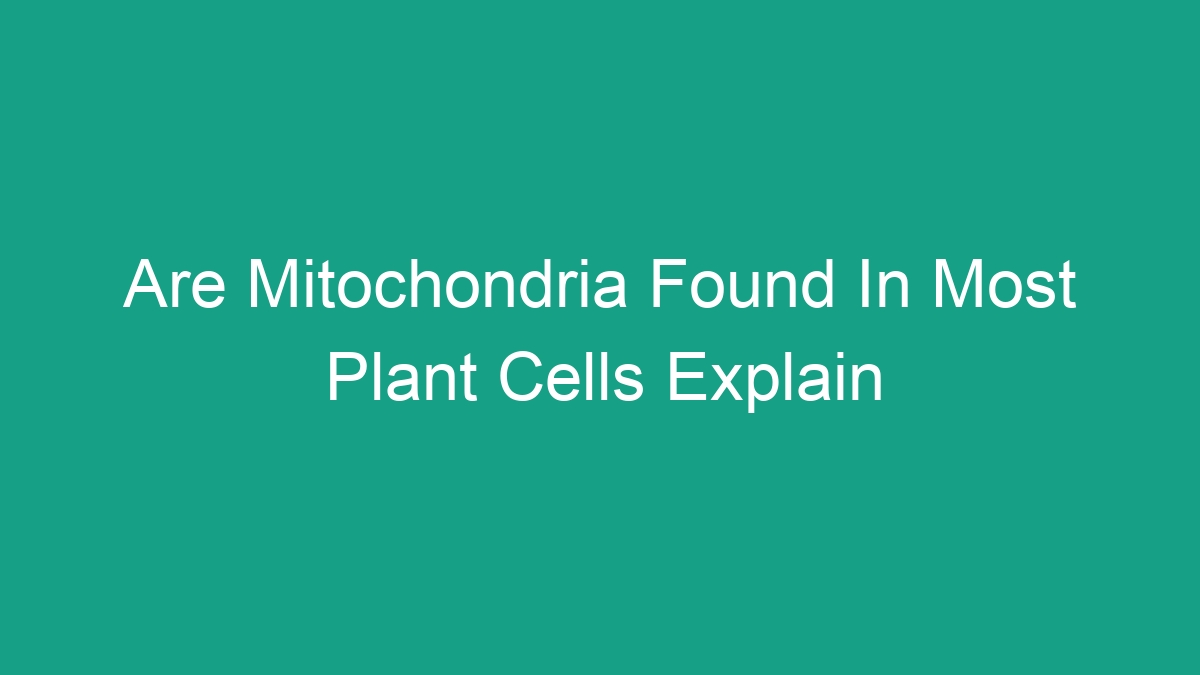
When we think of mitochondria, the first thing that usually comes to mind is animal cells. However, are mitochondria found in most plant cells? Let’s explore the fascinating world of plant cell biology and discover the role of mitochondria in these organisms.
What are Mitochondria?
Mitochondria are membrane-bound organelles found in the cytoplasm of eukaryotic cells. They are often referred to as the “powerhouses” of the cell because they generate the majority of the cell’s supply of adenosine triphosphate (ATP), which is used as a source of chemical energy. Mitochondria are also involved in a range of other cellular processes, including cell signaling, cell differentiation, and cell death.
Mitochondria in Plant Cells
Contrary to popular belief, mitochondria are indeed found in plant cells. In fact, plant cells contain a large number of mitochondria, just like animal cells. These mitochondria are essential for the respiration of plant cells, allowing them to convert glucose into ATP through the process of cellular respiration. This ATP provides the energy necessary for various cellular processes, such as growth, repair, and reproduction.
Functions of Mitochondria in Plant Cells
The presence of mitochondria in plant cells serves several vital functions:
- ATP Production: Just like in animal cells, mitochondria in plant cells are primarily responsible for ATP production.
- Respiration: Mitochondria facilitate the process of respiration in plant cells, allowing them to break down glucose and generate energy.
- Metabolism: Mitochondria are involved in numerous metabolic processes within plant cells, including the breakdown of fatty acids and the synthesis of certain amino acids.
- Cell Signaling: Mitochondria in plant cells play a role in cell signaling pathways that regulate various cellular activities.
- Apoptosis: Mitochondria are involved in the initiation of programmed cell death (apoptosis) in plant cells, which is essential for the removal of damaged or unwanted cells.
Mitochondrial DNA in Plant Cells
One interesting aspect of mitochondria is that they contain their own unique DNA, separate from the cell’s nuclear DNA. This mitochondrial DNA (mtDNA) is inherited maternally in most eukaryotic organisms, including plants. This means that when a plant reproduces, the mitochondria in the offspring are derived from the maternal parent.
This unique DNA allows mitochondria to produce some of the proteins necessary for their function independently of the cell’s nuclear DNA. In plant cells, this mtDNA plays a crucial role in the proper functioning of the mitochondria and the overall health of the cell.
Chloroplasts vs. Mitochondria in Plant Cells
Another organelle that is specific to plant cells is the chloroplast, which is responsible for photosynthesis. While both chloroplasts and mitochondria are involved in energy production, they have distinct functions and characteristics. Chloroplasts are responsible for converting light energy into chemical energy via the process of photosynthesis, producing glucose and oxygen, while mitochondria are involved in converting this glucose into ATP through cellular respiration.
Despite their different roles, both chloroplasts and mitochondria are essential for the overall energy metabolism of plant cells, working in tandem to provide the energy needed for growth and maintenance.
Conclusion
In conclusion, mitochondria are indeed found in most plant cells, carrying out essential functions such as ATP production, respiration, metabolism, cell signaling, and apoptosis. Their presence underscores the vital role of mitochondria in plant biology, contributing to the overall health and functionality of plant cells.
Despite the focus on animal cells in discussions about mitochondria, it is clear that these organelles are equally as important in plant cells.
FAQs
Q: Are there any plants that lack mitochondria?
No, all plant cells require mitochondria for their energy needs, so there are no known plant species that lack mitochondria entirely.
Q: Do all plant cells have the same number of mitochondria?
No, the number of mitochondria in plant cells can vary depending on the specific energy needs of the cell. For example, cells that require more energy for growth and metabolic processes may have a higher number of mitochondria.
Q: Can plants survive without mitochondria?
No, plants cannot survive without mitochondria. These organelles are essential for the production of ATP, which is the primary energy currency of the cell. Without mitochondria, plants would not be able to carry out essential cellular processes and would ultimately die.



